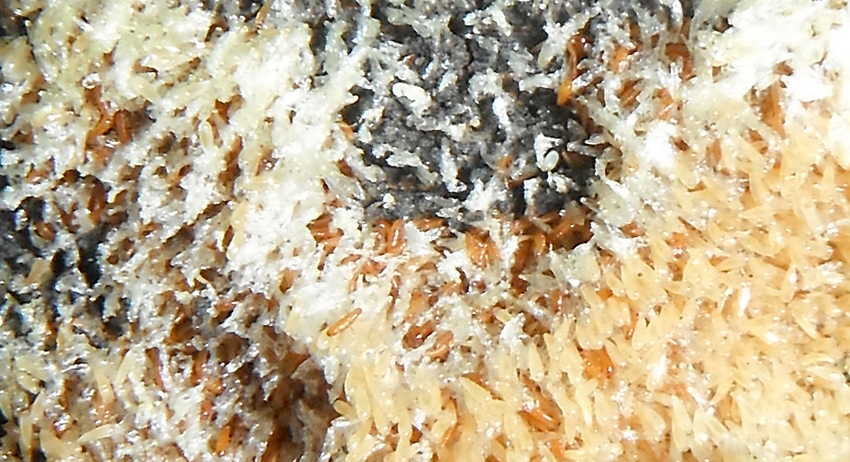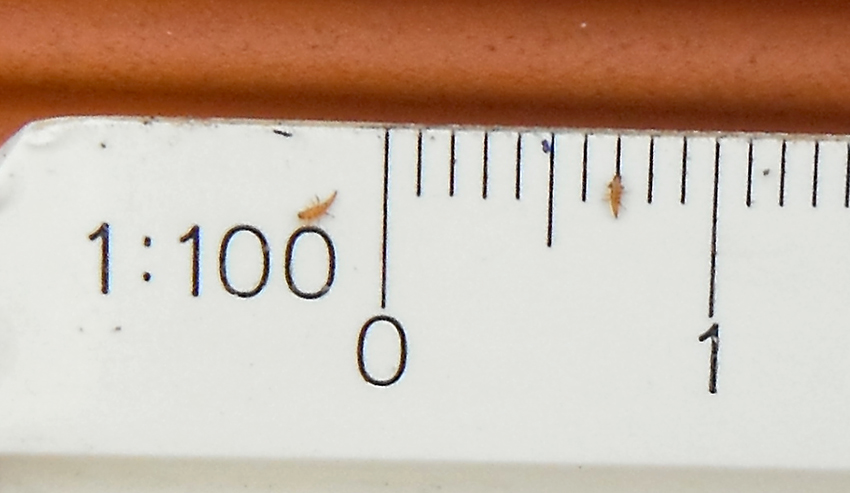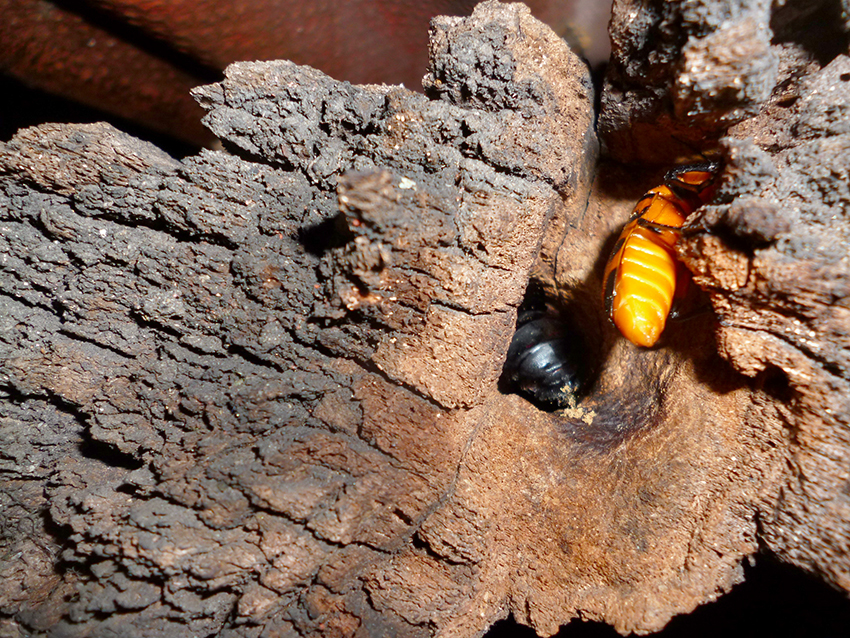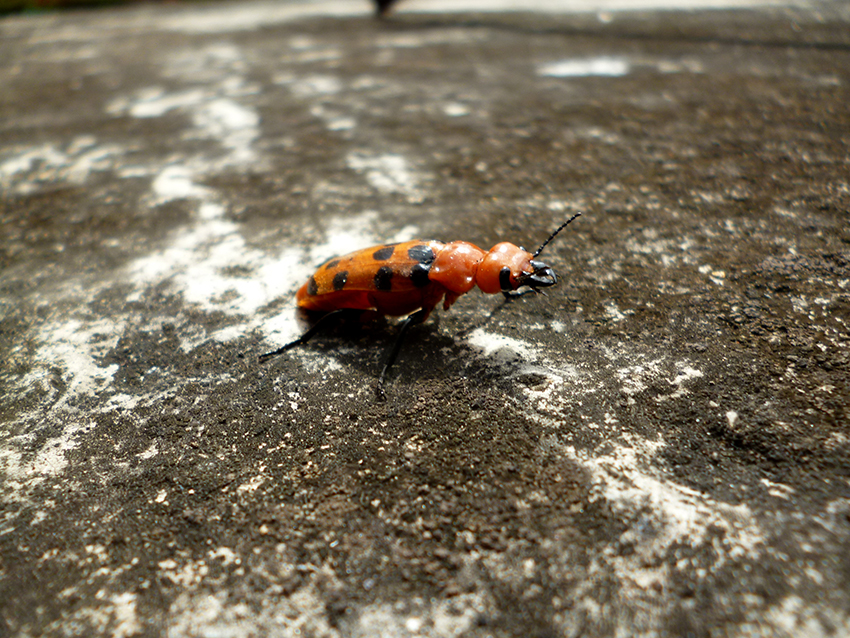El escarabajo cleptoparásito 'Cissites maculata' - The cleptoparasite beetle 'Cissites maculata'.
Recientemente hice una entrada sobre una investigación que me publicaron sobre un insecto, en esa entrada me referí a que en parte fue posible por la influencia del ecosistema Hive y comenté detalles sobre la investigación. En esta entrada comentaré sobre el insecto, principalmente, observaciones que documenté y que no documenté en la investigación.
I recently made a post about a research that I was published about an insect, in that post I referred that it was partly possible because of the influence of the Hive ecosystem and I commented details about the research. In this post I will comment on the insect, mainly observations that I documented and did not document in the research.
El insecto es un escarabajo que corresponde a la especie Cissites maculata, que es una de las dos especies que se encuentran en el Nuevo Mundo; la otra es la especie Cissites auriculata. Todas las fotografías que muestro son de varias hembras de la especie Cissites maculata.
The insect is a beetle corresponding to the species Cissites maculata, which is one of the two species found in the New World; the other is the species Cissites auriculata. All the photographs I show are of several females of the species Cissites maculata.



Inicialmente encontré, a finales del año 2020, a tres hembras en una viga de madera seca cerca de la entrada de un nido de abejas carpinteras del género Xylocopa sp. Su presencia fue debido a que estaban ovipositando debajo de la viga de madera. Estos escarabajos ovipositan cerca de la entrada de nidos de abejas carpinteras y otros himenópteros, para que cuando eclosionen sus huevos, las larvas de primer estadio conocidas como triungulinas, utilizan a las abejas como huéspedes. Tuve la oportunidad de ver, en la pata derecha trasera de una abeja entrando al nido, más de treinta larvas, y también tenía unas pocas en la pata izquierda (en la investigación aparece una foto). Las triungulinas se adhieren a las patas para que la abeja las transporte al interior del nido para ocupar las celdas de reservas alimenticias de las larvas de las abejas y alimentarse de ellas. Esa es la razón por la que estos escarabajos son cleptoparásitos; utilizan el alimento de las larvas de otros para alimentar a sus larvas.
I initially found, in late 2020, three females on a dry wooden beam near the entrance of a nest of carpenter bees of the genus Xylocopa sp. Their presence was because they were ovipositing under the wooden beam. These beetles oviposit near the entrance of carpenter bee nests and other hymenopterans, so that when their eggs hatch, the first instar larvae known as triungulins, use the bees as hosts. I had the opportunity to see, on the right hind leg of a bee entering the nest, more than thirty larvae, and it also had a few on the left leg (a photograph appears in the research). The triungulins attach themselves to the legs so that the bee can transport them into the nest to occupy the food reserve cells of the bee larvae and feed on them. That is why these beetles are cleptoparasites; they use the food from the larvae of others to feed their own larvae.


En la fotografía a continuación muestro a las tres hembras alrededor de la masa de huevos. En la superficie de la masa conté 1872 huevos. Esa masa de huevos en realidad eran dos masas unidas y cada masa estaba formada con hasta cuatro o cinco capas de huevos superpuestos en el centro de las masas, disminuyendo hasta dos o una capa en los bordes. La cantidad total de huevos que las masas contenían la calculé en aproximadamente 23400 huevos. La hembra que ve parcialmente en la parte de arriba en la fotografía, asumí no contribuyó con la postura.
In the photograph below I show the three females around the egg mass. On the surface of the mass I counted 1872 eggs. That egg mass was in reality two masses joined together and each mass was formed with up to four or five layers of eggs overlapping in the center of the masses, tapering down to two or one layer at the edges. The total number of eggs that the masses contained I calculated to be approximately 23400 eggs. The female that you see partially at the top in the photograph, I assumed, did not contribute to the laying.

En la siguiente fotografía muestro la masa de huevos, donde aproximadamente la mitad ya han eclosionado. Los huevos no eclosionados son los que presentan un color variable de blanco brillante, cremoso hasta marrón claro y en las cubiertas de los huevos eclosionados el color es blanco intenso; las cubiertas permanecen un tiempo pegadas entre sí. En la fotografía también se puede ver a las triungulinas, las cuales tienen una coloración marrón dorada.
In the next photograph I show the egg mass, where about half of the eggs have already hatched. The unhatched eggs are those that vary in color from bright white, creamy to light brown, and the covers of the hatched eggs are bright white; the covers remain glued together for some time. In the photograph you can also see the triungulins, which have a golden brown coloration.

La siguiente es una imagen detalle de la anterior en la que se puede apreciar un poco mejor a las triungulinas. También se pueden ver los huevos cuya forma es ovalada y larga, redondeada en un extremo y puntiaguda en el otro. Es de hacer notar que los huevos están depositados con el extremo puntiagudo hacia abajo.
The following is a detailed image of the previous one in which the triungulins can be seen a little better. You can also see the eggs whose shape is oval and long, rounded at one end and pointed at the other. It should be noted that the eggs are deposited with the pointed end downward.

En la fotografía a continuación se pueden ver dos triungulinas en el escalímetro, las triungulinas miden poco más de un milímetro.
In the photograph below you can see two triungulins in the scalimeter, the triungulins measure a little more than one millimeter.

En la siguiente imagen detalle de la anterior, se pueden ver mejor.
In the following image detail of the previous one, you can see them better.

En general el tamaño de las tres hembras fue 26,5; 29,8 y 30,9 milímetros de largo. Al medirlas cuando están vivas hay que destacar si tienen la cabeza ligeramente retraída, no tan retraída o muy retraída porque en la mayoría de los casos el comportamiento es el de permanecer inmóvil retrayendo en cierta medida la cabeza. Las tres fotografías siguientes corresponden a una hembra, de dos que vi, a finales del año 2022, en el mismo sitio del nido de Xylocopa sp., a esas hembras no las documenté en la investigación.
In general the size of the three females was 26.5; 29.8 and 30.9 millimeters long. When measuring them when they are alive it should be noted if they have the head slightly retracted, not so retracted or very retracted because in most cases the behavior is to remain immobile retracting the head to some extent. The following three photographs correspond to one female, of two that I saw, at the end of 2022, at the same site of the Xylocopa sp. nest, these females were not documented in the research.



La hembra en las tres fotografías anteriores tiene en su dorso polvo de polen. Eso fue debido más presumiblemente a que esa hembra frecuentó la entrada del nido de Xylocopa sp., y menos presumiblemente a la búsqueda de alimento.
The female in the three photographs above has pollen dust on her dorsum. That was more presumably due to that female frequenting the entrance of the Xylocopa sp. nest, and less presumably to food foraging.


Las dos hembras del año 2022, a diferencia de las tres del año 2020, caminaban bastante por la viga de madera aunque también se mantenían en reposo permaneciendo inmóviles. Incluso en algún momento una que estaba caminando se topó con la otra que estaba inmóvil y enseguida salió "corriendo" y la otra continuó permaneciendo inmóvil. Fue la única vez que vi a uno de esos escarabajos "corriendo". Las dos hembras no realizaron ninguna postura de huevos, solo permanecían en las inmediaciones del nido de la abeja y con bastante actividad frecuentando la entrada del nido, como queriendo entrar. Muestro seguidamente una imagen animada de una de ellas con intenciones de entrar.
The two 2022 females, unlike the three 2020 females, walked quite a bit on the wooden beam although they were also at rest remaining motionless. Even at one point one that was walking bumped into the other that was motionless and immediately took off "running" and the other continued to remain motionless. It was the only time I saw one of these beetles "running". The two females did not lay any eggs, they just remained in the vicinity of the bee's nest and were quite active in frequenting the nest entrance, as if they wanted to enter. I show below an animated image of one of them with the intention of entering.

Cabe destacar, que cuando alguno de los escarabajos intentaba meterse en el nido, a veces una abeja carpintera se encontraba cerca de la entrada y lo repelía atacándolo. El ataque era evidente por el movimiento brusco que veía en el escarabajo, el cual luego se giraba para huir, e incluso en algunas ocasiones logré ver a la abeja retrocediendo hacia dentro del nido cuando el escarabajo salía huyendo. Esos intentos de los escarabajos, asumo, ocasionaron que uno de ellos perdiera una pata derecha delantera; como se puede ver en la siguiente fotografía.
It is worth noting that when one of the beetles tried to get into the nest, sometimes a carpenter bee would be near the entrance and repel the beetle by attacking it. The attack was evident by the sudden movement I saw in the beetle, which then turned to flee, and sometimes I even managed to see the bee backing into the nest when the beetle fled. These attempts by the beetles, I assume, caused one of them to lose a right front leg; as can be seen in the following photograph.

Finalmente comentar que los tres escarabajos del año 2020, e incluso otros dos del año 2021 que tampoco realizaron postura de huevos y que si documenté en la investigación, murieron en las inmediaciones del nido de abejas carpinteras, pero los dos del año 2022 desaparecieron y no los vi más. Presumo que las hembras que hicieron postura mueren uno o dos días después de poner los últimos huevos, porque eso ha sido documentado para la otra especie (Cissites auriculata). Con relación a las que no realizaron postura es probable haya sido por adquirir una condición de debilidad por falta de energía, ya que en ningún momento durante las observaciones pude apreciar una ausencia que sugiriera se iban a buscar alimento.
Finally, the three beetles of the year 2020, and even two others of the year 2021 that also did not lay eggs and that I documented in the research, died in the vicinity of the carpenter bee nest, but the two of the year 2022 disappeared and I did not see them anymore. I presume that the females that laid eggs die one or two days after laying the last eggs, because that has been documented for the other species (Cissites auriculata). Regarding those that did not lay eggs, it was probably because they acquired a weak condition due to lack of energy, since at no time during the observations did I see an absence that suggested that they were going to forage for food.

Se puede ver un video que hice con una narrativa similar (en español), que incluye videos y otras fotografías distintas a las de esta entrada.
You can watch a video I made with a similar narrative (in Spanish), which includes videos and other photographs different from the ones in this post.

Images captured with Panasonic DMC-FH4 digital camera.

0
0
0.000
@tipu curate 2
Upvoted 👌 (Mana: 0/50) Liquid rewards.
Gracias @esalcedo, éxitos.
Su post ha sido valorado por @ramonycajal
Saludos equipo @ramonycajal, gracias por la valoración.
Thanks for your contribution to the STEMsocial community. Feel free to join us on discord to get to know the rest of us!
Please consider delegating to the @stemsocial account (85% of the curation rewards are returned).
You may also include @stemsocial as a beneficiary of the rewards of this post to get a stronger support.
Gracias equipo @stemsocial (@steemstem), saludos.